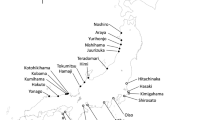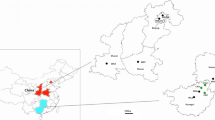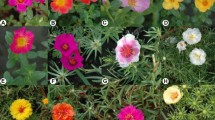Abstract
Although the original Saccharina japonica populations in China are assumed to have been accidentally introduced from Japan in 1920s, few investigations have been performed to prove it. Genetic structure analysis is expected to shed light on this question. In the present study, 11 highly polymorphic microsatellite markers were employed to analyze the genetic structure of representative populations of S. japonica in the Northwest Pacific, including the four varieties from Japan. Populations from China had a much lower level of genetic diversity than the ones from Japan in terms of the number of alleles, private alleles and locally common alleles, and the values of heterozygosity, suggestive of the founder effect in the introduced populations. Both the Bayesian model-based and genetic distance-based analyses revealed three major clusters: (1) S. japonica var. japonica, var. religiosa, and var. ochotensis from Hokkaido, as well as the populations from Korea and Russia; (2) populations from China; and (3) var. diabolica. Saccharina japonica var. diabolica harbored the highest number of private alleles, with three of them having a frequency of 1.00 at three loci, which have the potential to be used as specific markers to distinguish this variety from others. Significant genetic differentiation was found between almost all the populations except for a few cultivated populations from China. Populations from China were most closely related to S. japonica var. japonica, which was in turn most close to var. religiosa and the Korean population. The microsatellite markers used in this study were shown to be polymorphic enough to decipher the subtle genetic structure of S. japonica, including the different varieties.




Similar content being viewed by others
References
Earl DA, vonHoldt BM (2011) STRUCTURE HARVESTER: a website and program for visualizing STRUCTURE output and implementing the Evanno method. Conserv Genet Resour 4:359–361
Emanuelli F, Lorenzi S, Grzeskowiak L, Catalano V, Stefanini M, Troggio M, Myles S, Martinez-Zapater JM, Zyprian E, Moreira FM (2013) Genetic diversity and population structure assessed by SSR and SNP markers in a large germplasm collection of grape. BMC Plant Biol 13:39
Evanno G, Regnaut S, Goudet J (2005) Detecting the number of clusters of individuals using the software STRUCTURE: a simulation study. Mol Ecol 14:2611–2620
Excoffier L, Laval G, Schneider S (2005) Arlequin (version 3.0): an integrated software package for population genetics data analysis. Evol Bioinformatics Online 1:47
Fishery Bureau of Ministry of Agriculture of China (2014) China fishery statistical yearbook, 2014. China Agriculture Press, Beijing, p 29 (in Chinese)
Hedgecock D, Sly F (1990) Genetic drift and effective population sizes of hatchery-propagated stocks of the Pacific oyster, Crassostrea gigas. Aquaculture 88:21–38
Lane CE, Mayes C, Druehl LD, Saunders GW (2006) A multi-gene molecular investigation of the kelp (Laminariales, Phaeophyceae) supports substantial taxonomic re-organization. J Phycol 42:493–512
Li HJ (1990) Notes on the Laminaria raft cultivation method. Mariculture 1(2):41–48 (in Chinese)
Li X, Liu J, Cong Y, Qu S, Zhang Z, Dai H, Luo S, Han X, Huang S, Wang Q, Liang G, Sun J, Jin Y, Wang D, Yang G (2008) Breeding and trial cultivation of Dongfang No. 3, a hybrid of Laminaria gametophyte clones with a more than intraspecific but less than interspecific relationship. Aquaculture 280:76–80
Li J, Pang S, Liu F, Shan T, Gao S (2013) Spermatozoid life-span of two brown seaweeds, Saccharina japonica and Undaria pinnatifida, as measured by fertilization efficiency. Chin J Oceanol Limnol 31:774–781
Li Q, Zhang J, Yao J, Wang X, Duan D (2016a) Development of Saccharina japonica genomic SSR markers using next-generation sequencing. J Appl Phycol 28:1387–1390
Li X, Zhang Z, Qu S, Liang G, Zhao N, Sun J, Song S, Cao Z, Li X, Pan J, Luo S, Zhang L, Cui C, Peng J, Li Y, Wu R, Zhao J, Qian R, Wang L, Sai S, Yang G (2016b) Breeding of an intraspecific kelp hybrid Dongfang no. 6 (Saccharina japonica, Phaeophyceae, Laminariales) for suitable processing products and evaluation of its culture performance. J Appl Phycol 28:439–447
Liu ZJ, Cordes JF (2004) DNA marker technologies and their applications in aquaculture genetics. Aquaculture 238:1–37
Liu F, Wang X, Yao J, Fu W, Duan D (2009) Development of expressed sequence tag-derived microsatellite markers for Saccharina (Laminaria) japonica. J Appl Phycol 22:109–111
Liu F, Yao J, Wang X, Repnikova A, Galanin DA, Duan D (2012) Genetic diversity and structure within and between wild and cultivated Saccharina japonica (Laminariales, Phaeophyta) revealed by SSR markers. Aquaculture 358–359:139–145
Maeda T, Yotsukura N (2013) Development of microsatellite markers for Saccharina japonica by dual-suppression PCR. Algal Res 6:67–71
Miyabe K (1902) Laminariaceae. Hokkaido Suisan Chosahokoku. Hokkaido Shokuminbu 3:1–60 (in Japanese)
Nei M (1972) Genetic distance between populations. Am Nat 106:283–292
Pang SJ, Jin ZH, Sun JZ, Gao SQ (2007) Temperature tolerance of young sporophytes from two populations of Laminaria japonica revealed by chlorophyll fluorescence measurements and short-term growth and survival performances in tank culture. Aquaculture 262:493–503
Peakall R, Smouse PE (2006) Genalex 6: genetic analysis in Excel. Population genetic software for teaching and research. Mol Ecol Notes 6:288–295
Peakall R, Smouse PE (2012) GenAlEx 6.5: genetic analysis in Excel. Population genetic software for teaching and research--an update. Bioinformatics 28:2537–2539
Pritchard JK, Stephens M, Donnelly P (2000) Inference of population structure using multilocus genotype data. Genetics 155:945–959
Samuel AF, Drucker AG, Andersen SB, Simianer H, van Zonneveld M (2013) Development of a cost-effective diversity-maximising decision-support tool for in situ crop genetic resources conservation: the case of cacao. Ecol Econ 96:155–164
Shan TF, Liu F, Liu QS, Pang SJ (2011a) An overview of the “summer sporeling” technique of Saccharina japonica in China. J Agric Sci Technol 13(2):129–134 (in Chinese with English abstract)
Shan TF, Pang SJ, Zhang YR, Yakovleva IM, Skriptsova AV (2011b) An AFLP-based survey of genetic diversity and relationships of major farmed cultivars and geographically isolated wild populations of Saccharina japonica (Phaeophyta) along the northwest coasts of the Pacific. J Appl Phycol 23:35–45
Shi Y, Yang G, Liu Y, Liao M, Li X, Cong Y (2007) Development of 18 polymorphic microsatellite DNA markers of Laminaria japonica (Phaeophyceae). Mol Ecol Notes 7:620–622
Sitther V, Zhang D, Harris DL, Yadav AK, Zee FT, Meinhardt LW, Dhekney SA (2014) Genetic characterization of guava (Psidium guajava L.) germplasm in the United States using microsatellite markers. Genet Resour Crop Evol 61:829–839
Tseng CK (2001) Algal biotechnology industries and research activities in China. J Appl Phycol 13:375–380
Tseng CK, Zhang JF (1952) Economic seaweeds in the north of China. J Shandong Univ 2:57–82 (in Chinese with English abstract)
Wang L, Zhang H, Song L, Guo X (2007) Loss of allele diversity in introduced populations of the hermaphroditic bay scallop Argopecten irradians. Aquaculture 271:252–259
Ye N, Zhang X, Miao M, Fan X, Zheng Y, Xu D, Wang J, Zhou L, Wang D, Gao Y, Wang Y, Shi W, Ji P, Li D, Guan Z, Shao C, Zhuang Z, Gao Z, Qi J, Zhao F (2015) Saccharina genomes provide novel insight into kelp biology. Nat Commun 6:6986
Yotsukura N (2005) Molecular phylogeny of advanced kelps (Laminariales, Phaeophyceae) growing in Japan. Nat Hist Res Spec 8:69–81
Yotsukura N, Kawai T, Kawashima S, Ebata H, Ichimura T (2006) Nucleotide sequences diversity of the 5S rDNA spacer in the simple blade genera Laminaria, Cymathaere and Kjellmaniella (Laminariales, Phaeophyceae) from northern Japan. Phycol Res 54:269–279
Yotsukura N, Kawashima S, Kawai T, Abe T, Druehl L (2008) A systematic re-examination of four Laminaria species: L. japonica, L. religiosa, L. ochotensis and L. diabolica. J Jpn Bot 83:165–176
Yotsukura N, Shimizu T, Katayama T, Druehl LD (2010) Mitochondrial DNA sequence variation of four Saccharina species (Laminariales, Phaeophyceae) growing in Japan. J Appl Phycol 22:243–251
Yu Z, Guo X (2004) Genetic analysis of selected strains of eastern oyster (Crassostrea virginica Gmelin) using AFLP and microsatellite markers. Mar Biotechnol 6:575–586
Zane L, Bargelloni L, Patarnello T (2002) Strategies for microsatellite isolation: a review. Mol Ecol 11:1–16
Zhang QS, Tang XX, Cong YZ, Qu SC, Luo SJ, Yang GP (2007) Breeding of an elite Laminaria variety 90–1 through inter-specific gametophyte crossing. J Appl Phycol 19:303–311
Zhang QS, Yuan SY, Cong YZ, Qu SC, Yang GP (2008) AFLP analysis of the gametophyte clones derived from introduced Laminaria (Phaeophyta) and cultured varieties of China. Periodical Ocean Univ China 3:016
Zhang J, Li W, Qu J, Wang X, Liu C, Liu T (2014a) Development and characterization of microsatellite markers from an enriched genomic library of Saccharina japonica. J Appl Phycol 27:479–487
Zhang L, Peng J, Li X, Liu Y, Cui C, Wu H, Wu R, Tian P, Li Y (2014b) Development of 27 trinucleotide microsatellite markers for Saccharina japonica using next generation sequencing technology. Conserv Genet Resour 6:341–344
Zhang J, Yao JT, Sun ZM, Fu G, Galanin DA, Nagasato C, Motomura T, Hu ZM, Duan DL (2015) Phylogeographic data revealed shallow genetic structure in the kelp Saccharina japonica (Laminariales, Phaeophyta). BMC Evol Biol 15:237
Zhao XB, Pang SJ, Liu F, Shan TF, Li J, Gao SQ, Kim HG (2016) Intraspecific crossing of Saccharina japonica using distantly related unialgal gametophytes benefits kelp farming by improving blade quality and productivity at Sanggou Bay, China. J Appl Phycol 28:449–455
Zonneveld M, Scheldeman X, Escribano P, Viruel MA, Van Damme P, Garcia W, Tapia C, Romero J, Siguenas M, Hormaza JI (2012) Mapping genetic diversity of cherimoya (Annona cherimola Mill.): application of spatial analysis for conservation and use of plant genetic resources. PLoS One 7(1):e29845
Acknowledgments
The authors would like to thank Nobu Nagai for his patient assistance in microsatellite genotyping procedure and Masumi Kounoe, Hiromi Kato, Seiko Tamano, and Tadashi Kawai for their kind help in sample collection and handling. Special thanks go to Xia Li for her constructive suggestions in data analysis. This study was supported by a Fellowship Program for Overseas Researchers granted to Tifeng Shan by Hokkaido University, the scientific and technological innovation project from Qingdao National Laboratory for Marine Science and Technology (No. 2015ASKJ01), the Open Fund of Laboratory for Marine Biology and Biotechnology, Qingdao National Laboratory for Marine Science and Technology (No. OF2015N010), the STS program from the Chinese Academy of Sciences, and a project from the National Infrastructure of Fishery Germplasm Resource (2016DKA30470).
Author information
Authors and Affiliations
Corresponding author
Rights and permissions
About this article
Cite this article
Shan, T., Yotsukura, N. & Pang, S. Novel implications on the genetic structure of representative populations of Saccharina japonica (Phaeophyceae) in the Northwest Pacific as revealed by highly polymorphic microsatellite markers. J Appl Phycol 29, 631–638 (2017). https://doi.org/10.1007/s10811-016-0888-2
Received:
Revised:
Accepted:
Published:
Issue Date:
DOI: https://doi.org/10.1007/s10811-016-0888-2




